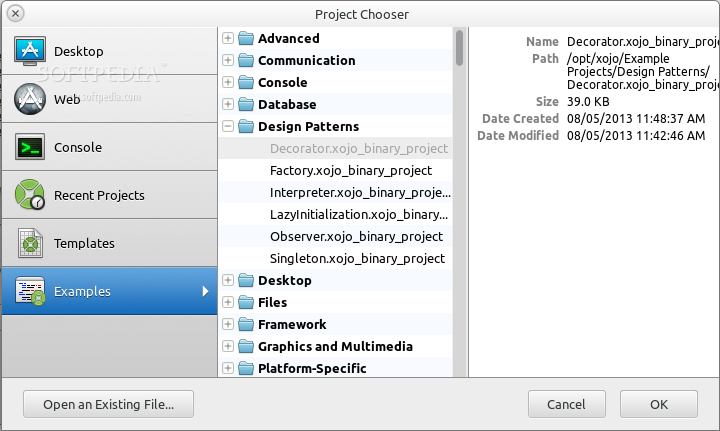

- XOJO EXAMPLES PDF
- XOJO EXAMPLES INSTALL
- XOJO EXAMPLES FULL
- XOJO EXAMPLES SOFTWARE
- XOJO EXAMPLES CODE

Set and get document properties (title, author, subject, keyword).
XOJO EXAMPLES PDF
Generate QR codes and add them to PDF files.Add text and control location, size, color and font.Add images to existing PDF files and convert images to PDF files (JPG, GIF, TIFF, PNG, BMP, etc).

Load existing PDFs or generate new ones.
XOJO EXAMPLES FULL
A full list of functions can be found in the ∺ppendix C: Functions available in the Lite Edition section found in the Function Reference provided with the installer. These are some of the key functions in this free PDF SDK. The examples I showed works fine with the free version… You will however need the paid version to control fonts and a number of other features. MsgBox ("Could not save the PDF file: "+OutPutFile ) Stf = PDFLibrary.SaveToFile( OutPutFile ) PDFLibrary.DrawImage( 0, PDFLibrary.PageHeight, IWidth, IHeight ) Draw the image onto the page using the the images PDFLibrary.SetPageDimensions( IWidth, IHeight ) PDFLibrary.AddImageFromFile( ImageFile, 0 ) OutPutFile = "C:\\TEMP\\PDF\\ImagetoPdf.pdf" ImageFile = "C:\\TEMP\\PDF\\Xojo_images.jpg" Import image to pdf // Import image to pdf MsgBox ("Could not save the PDF file: "+pdfFile) Stf = 0 "The file could not be created", Stf = 1 "The file was created successfully" PDFLibrary.DrawText(100, 500, "Hello from XOJO") PDFLibrary = NEW OLEObject("DebenuPDFLibraryLite1112.PDFLibrary") PdfFile = "C:\\TEMP\\PDF\\HelloFromXojo.pdf" And the “Debenu Quick PDF Library 11.12 Reference Guide.pdf” will explain howto use the Library.Ĭreate a PDF document with text: “Hello from XOJO” // Create a PDF document with text: "Hello from XOJO" Read the GettingStarted.pdf file which explains howto registering the ActiveX DLL.
XOJO EXAMPLES INSTALL
( )Ĭheck the license agreement before you install it, as the license agreement could have changes while you are reading this
XOJO EXAMPLES SOFTWARE
Which allow you to install the LICENSED SOFTWARE on any number of computers, for any number of developers for both personal or commercial use. This description appears in the Add Event Handler window when the event is selected.Some of you might be interested in using the Debenu Free PDF Library Lite to create PDF documents or Convert images to Pdf.

When you create an event definition, you can enter a description for it in the Description field on the Advanced (gear) tab of the Inspector. You can easily add a matching event definition by right-clicking on the event you have implemented and choosing "Create Event Definition from Event". If you want the event handler to still be available to additional subclasses, you need to create a new event definition in the subclass (matching the name and parameters) and then call it in from event handler you implemented. Note that when you implement an event handler, it no longer appears in subclasses. The built-in control classes all contain a wide variety of event handlers (such as Opening), all of which work in this manner.
XOJO EXAMPLES CODE
Since you are not overridden the Save method, your code circumvents the possible issue shown above. Add those event handlers and implement them as needed. When you create a subclass, you will see that it has two Event Handlers you can add to it: PreSave and PostSave. In the Save method on the super class, you then call PreSave at the beginning and PostSave at the end. With events, you create two event definitions on the super class: PreSave and PostSave. If you forget to call Super.Save then your overridden method won't actually save! But if you do this with events, then there is no room for error. This works but it relies on you defining and implementing everything properly. They are shared versions of computed properties. Shared Computed Properties work exactly like you expect. (For information about constructors and destructors, see the section Constructors and Destructors.) When you access it, it gives you the current number of instances of the class. Each time you create or destroy an instance of the class, you can increment the value of the shared property in its constructor and decrement it in its destructor. For example, if you are using an instance of a class to keep track of items (e.g., persons, merchandise, sales transactions, and so forth) you can use a shared property as a counter. Generally speaking, shared properties are an advanced feature that you only need in special cases. It is important to understand that if you change the value of a shared property, the change is available to every usage of the shared property. In many ways, a public shared property works like a protected module property. A shared property can be accessed from anywhere its scope allows.


 0 kommentar(er)
0 kommentar(er)
